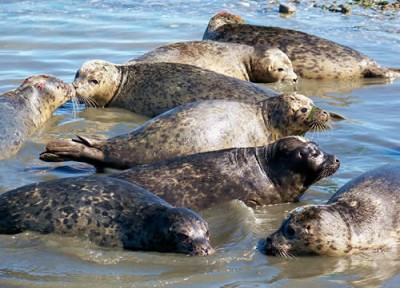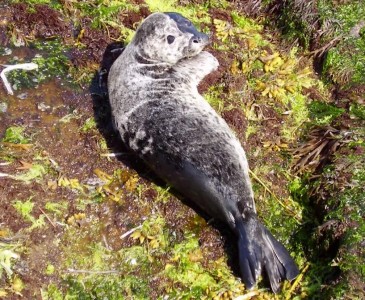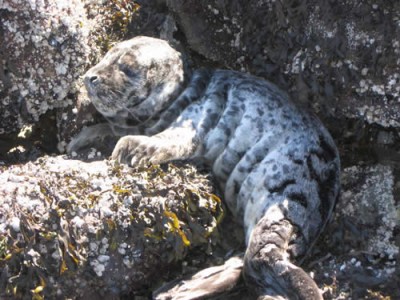Harbour Seals (pinnipeds) are resident to B.C. waters year – round. They are found from Alaska to California but do not migrate and tend to stay in the area where they were born. Rocky outcroppings or beaches known as “haul-outs” are where seals rest and give birth.
Harbour seals have a spindle shaped body, a robust rounded head with a broad snout. Large eyes enable them to see in dark and murky waters. Mucus continually washes over the eyes to protect them, as seals do not have tear ducts. When out of the water seals have a wet “tear-rimmed” look. Sharp front teeth for grasping and tearing food (not chewing) and strong back teeth for crushing shells or crustaceans. Predominate whiskers (vibrissae) grow from thick pads of a seals lips and cheeks. Whiskers are used to locate food in deep dark waters or at night. Their coats range from silver grey, brownish black with lots of spots and rings creating a speckled pattern. Males can reach up to 2m in length and weigh up to 170kg whereas the smaller female reaches up to 1.7m and weighs 150kg.
 Fore flippers are short, webbed, furry and clawed. Claws are used for scratching, grooming and defense. Hind flippers are the same but are unable to rotate under their bodies; so on land, seals must undulate like a caterpillar to move about. This all changes once in the water where they are sublime swimmers moving their hind flippers side to side as they propel through the water.
Fore flippers are short, webbed, furry and clawed. Claws are used for scratching, grooming and defense. Hind flippers are the same but are unable to rotate under their bodies; so on land, seals must undulate like a caterpillar to move about. This all changes once in the water where they are sublime swimmers moving their hind flippers side to side as they propel through the water.
Most food is found in shallow water but a seal can dive 300m and/or stay submerged up to thirty minutes. They have a high content of oxygen binding protein myogoblin (ten times as much as humans), which prevents oxygen in the muscles from deteriorating. Squid, crustaceans, mollusks, rockfish, herring, flounder and hake are dinner for seals.
 After a gestation period from nine to eleven months seal pups are born late JUNE, JULY, AUGUST. They weigh about 13 kg and within a day are able to swim and dive. They stay with mom feeding on the rich milk she provides but are weaned abruptly within four to six weeks.
After a gestation period from nine to eleven months seal pups are born late JUNE, JULY, AUGUST. They weigh about 13 kg and within a day are able to swim and dive. They stay with mom feeding on the rich milk she provides but are weaned abruptly within four to six weeks.
Killer whales, fishing nets, boat traffic, plastic debris, polluted oceans (PCBs, DDTs) are faced daily by these beautiful creatures. Toxins found in seals tend to compromise their immune systems.
In 2008, GROWLS rescued 18 seal pups under the authority of Island Wildlife Natural Care Centre on Saltspring Island.
Should you encounter a lone seal pup, above the tide line, hot day, busy beach area, threat of predation, no seals sighted off shore, call GROWLS EMERGENCY PAGER 250 714-7101 a GROWLS volunteer will come and assess if this seal pup should be rescued.

DO NOT:
- DO NOT touch, move, disturb, or harass the seal pup
- DO NOT try to feed the seal
- DO NOT pour water on the seal often they are on shore to dry off
- DO NOT force the seal pup into the water
DO:
- DO stay a safe distance away from the seal
- DO keep pets and children away to avoid harmful interaction
- DO observe the condition, size, and location of the seal pup
- DO call GROWLS 250 714-7101 if you believe the seal pup is sick, injured, or abandoned
